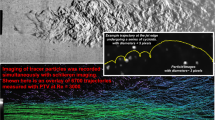Abstract
Particle-laden turbulent flows are relevant to many industrial, biological, and environmental applications. In these flows, there are many interactions that occur between the carrier-fluid turbulence and the dispersed particles inside; visualization tools aid in understanding the complex physical phenomena at various spatial and time scales in such flows. For a large scale 3D particle-laden turbulence, visualizing the vector data in a dynamic environment makes the computation expensive. Furthermore, the interaction between the turbulence and particles is difficult to observe in 3D. The particle-turbulence interaction is easy to observe using 2D visualization, yet 2D visualization cannot properly capture the dynamics of the interactions. In this paper, we explore a method which can visualize the 3D effect of particle-turbulence interaction as a 2D trajectory visualization. We divide the 3D particle trajectory into several segments and, for each, we compute the plane crossing the line segment. As the turbulence vectors across the plane have a significant impact on the particle motion, we only visualize the planes where the particles are localized. Since we select the salient planes to visualize instead of the whole 3D vector cube, considerable improvements can be achieved with regards to the memory and time performance. For each plane, we use Line Integral Convolution to visualize the turbulence. Originally, Line Integral Convolution only visualizes the vectors’ direction. Instead, we not only visualize the vector directions but also the magnitude of the flow by utilizing a more meaningful texture, which generates a more compelling visualization.
Supported by NSF OCI-0904534
Access this chapter
Tax calculation will be finalised at checkout
Purchases are for personal use only
Preview
Unable to display preview. Download preview PDF.
Similar content being viewed by others
References
Ayala, O., Grabowski, W., Wang, L.P.: A hybrid approach for simulating turbulent collisions of hydrodynamically-interacting particles. J. Comput. Phys. 225 (2007)
Bec, J., Biferale, L., Cencini, M., Lanotte, A., Musacchio, S., Toschi, F.: Heavy particle concentration in turbulence at dissipative and inertial scales. Phys. Rev. Lett. 98 (2007)
Cabral, B., Leedom, L.C.: Imaging vector fields using line integral convolution. In: Proceedings of the 20th Annual Conference on Computer Graphics and Interactive Techniques (1993)
Coleman, S., Vassilicos, J.: A unified sweep-stick mechanism to explain particle clustering in two-and three-dimensional homogeneous, isotropic turbulence. Physics of Fluids 21 (2009)
Grabowski, W., Wang, L.P.: Growth of cloud droplets in a turbulent environment. Annual Review of Fluid Mechanics 45 (2013)
Hin, A., Post, F.: Visualization of turbulent flow with particles. In: Proceedings of the 4th Conference on Visualization 1993 (1993)
Inostroza, M., Berretta, R., Moscato, P.: Qapgrid: A two level qap-based approach for large-scale data analysis and visualization. PloS One 6 (2011)
Leigh, J., Johnson, A., Renambot, L., Vishwanath, V., Peterka, T., Schwarz, N.: Visualization of large-scale distributed data. Data Intensive Distributed Computing: Challenges and Solutions for Large-Scale Information Management (2010)
Moreland, K., Rogers, D., Greenfield, J., Geveci, B., Marion, P., Neundorf, A., Eschenberg, K.: Large scale visualization on the cray xt3 using paraview. Cray User Group (2008)
MV, R., Parishani, H., Ayala, O., Wang, L.-P., Kambhamettu, C.: CollisionExplorer: A tool for visualizing droplet collisions in a turbulent flow. In: Bebis, G., Boyle, R., Parvin, B., Koracin, D., Wang, S., Kyungnam, K., Benes, B., Moreland, K., Borst, C., DiVerdi, S., Yi-Jen, C., Ming, J. (eds.) ISVC 2011, Part II. LNCS, vol. 6939, pp. 669–680. Springer, Heidelberg (2011)
Shen, H.W., Johnson, C.R., Ma, K.L.: Visualizing vector fields using line integral convolution and dye advection. In: Proceedings of the 1996 Symposium on Volume Visualization (1996)
Shi, L., Cao, N., Liu, S., Qian, W., Tan, L., Wang, G., Sun, J., Lin, C.: Himap: Adaptive visualization of large-scale online social networks. In: 2009 IEEE Pacific Visualization Symposium (2009)
Stalling, D., Hege, H.-C.: Fast and resolution independent line integral convolution. In: Proceedings of the 22nd Annual Conference on Computer Graphics and Interactive Techniques (1995)
Sundquist, A.: Dynamic line integral convolution for visualizing streamline evolution. IEEE Transactions on Visualization and Computer Graphics 9 (2003)
Toschi, F., Bodenschatz, E.: Lagrangian properties of particles in turbulence. Annual Review of Fluid Mechanics 41 (2009)
Treib, M., Burger, K., Reichl, F., Meneveau, C., Szalay, A., Westermann, R.: Turbulence visualization at the terascale on desktop pcs. IEEE Transactions on Visualization and Computer Graphics 18 (2012)
Treib, M., Reichl, F., Auer, S., Westermann, R.: Interactive editing of gigasample terrain fields. Computer Graphics Forum 31 (2012)
Yang, T.S., Shy, S.S.: Two-way interaction between solid particles and homogeneous air turbulence: particle settling rate and turbulence modification measurements. Journal of Fluid Mechanics 526 (2005)
Author information
Authors and Affiliations
Editor information
Editors and Affiliations
Rights and permissions
Copyright information
© 2013 Springer-Verlag Berlin Heidelberg
About this paper
Cite this paper
Lu, G. et al. (2013). A Tool for Visualizing Large-Scale Interactions between Turbulence and Particles in 3D Space through 2D Trajectory Visualization. In: Bebis, G., et al. Advances in Visual Computing. ISVC 2013. Lecture Notes in Computer Science, vol 8034. Springer, Berlin, Heidelberg. https://doi.org/10.1007/978-3-642-41939-3_5
Download citation
DOI: https://doi.org/10.1007/978-3-642-41939-3_5
Publisher Name: Springer, Berlin, Heidelberg
Print ISBN: 978-3-642-41938-6
Online ISBN: 978-3-642-41939-3
eBook Packages: Computer ScienceComputer Science (R0)




